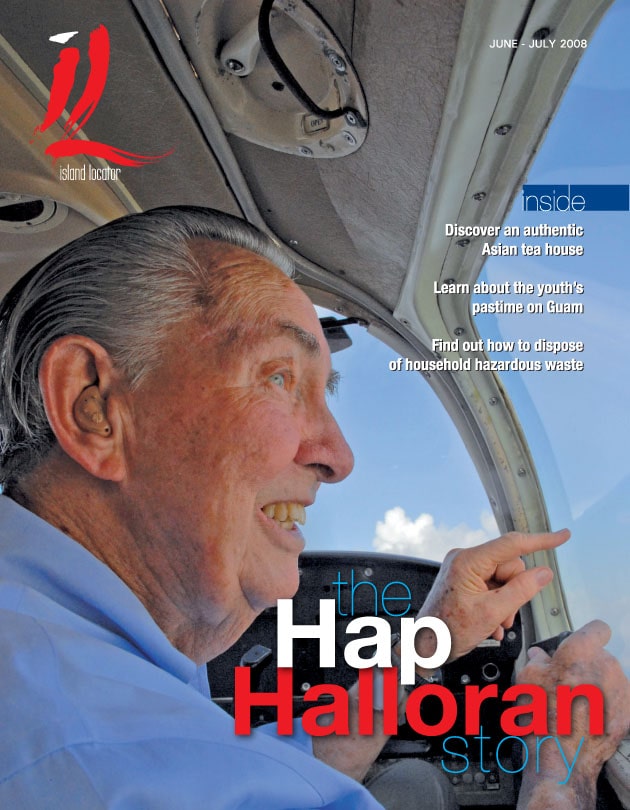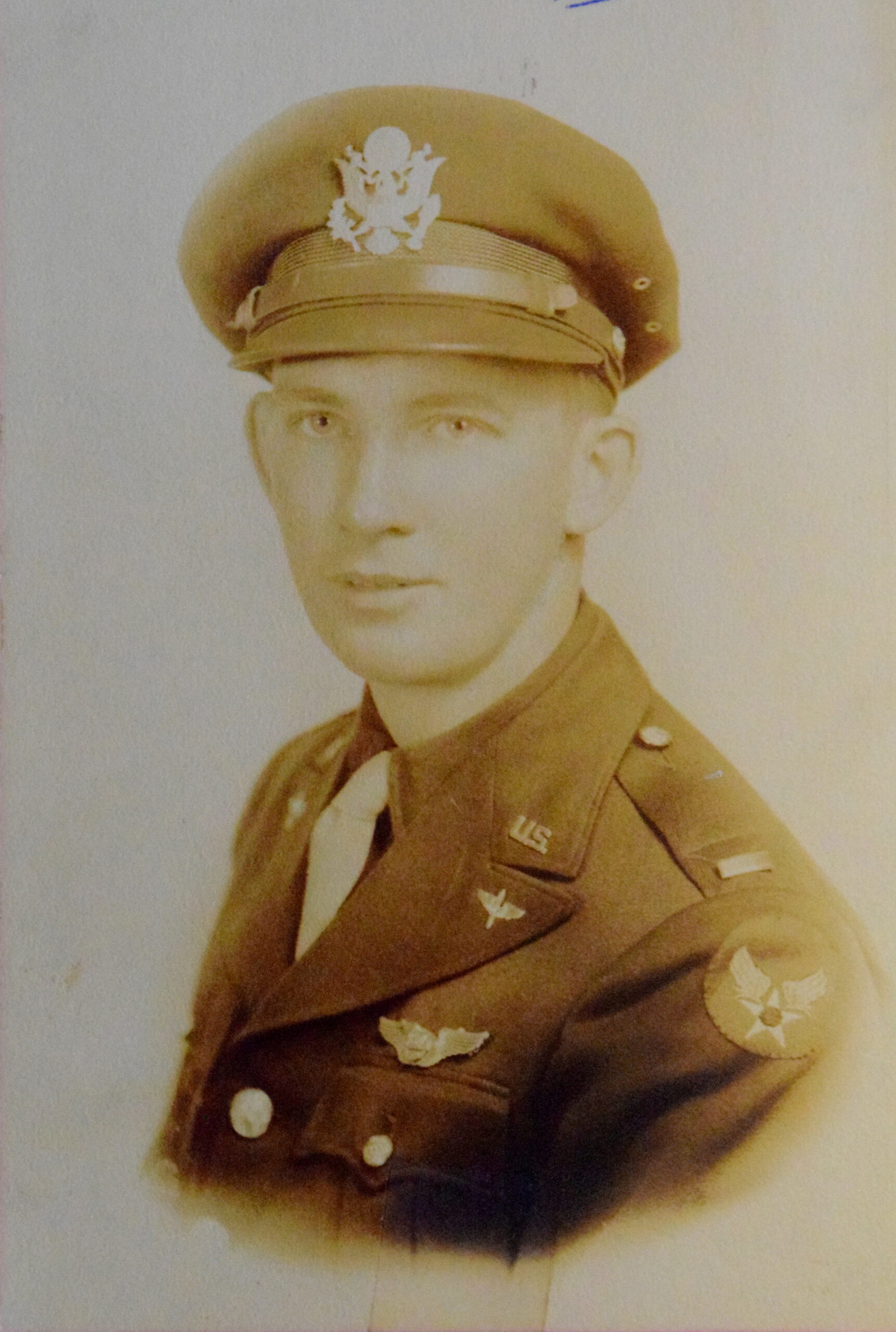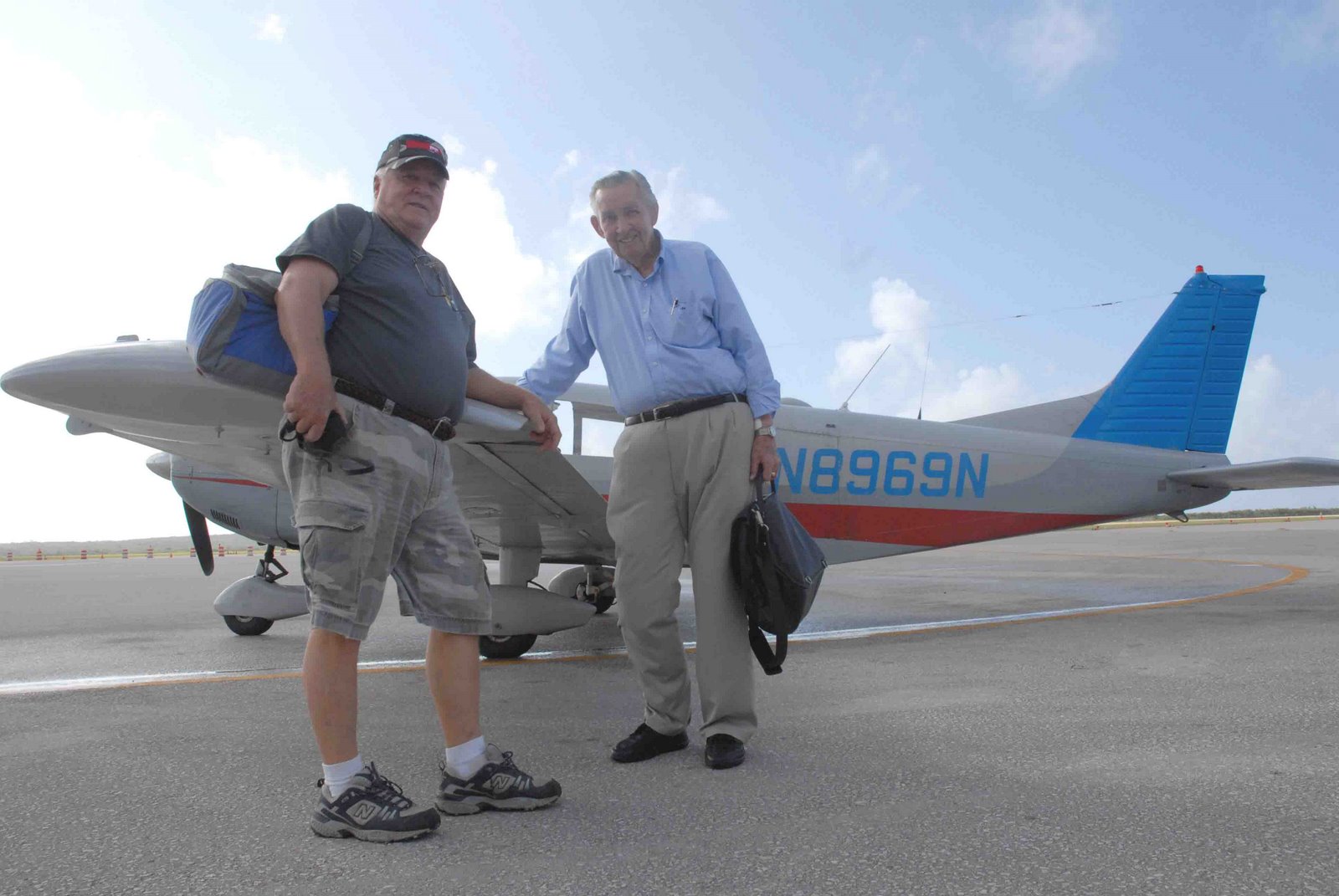


World War II B-29 navigator Raymond “Hap” Halloran, who died in Menlo Park on June 7, 2011, was based at Isely Field on Saipan in 1944 and was taken prisoner of war in Japan for seven months until he was freed at the end of the war.
Growing up in Cincinnati, Ohio during the Great Depression, Hap said their family of seven lived in a two-and-a-half-bedroom home where “lots of love offset the shortage of money.”
Even as a young boy, Hap had a longing to fly planes. Whenever a small plane would fly over their home in Cincinnati, he would run outside and shout, “Hey mister, give me a ride.”
He loved making model airplanes and proudly hung them from the ceiling in the bedroom he shared with his two brothers.
Airplanes were the joy of his life.
His first ride took him to Washington D.C. for $1.50. He also paid $3 to take a 30-minute flight from Cincinnati to Dayton.
When not busy with making model planes, golf fascinated the young Hap. He worked at the Ridgewood Golf Club where he was paid 50 cents to caddy for 18 holes.
When Pearl Harbor was attacked, Hap knew he had to fulfill his duty to the country.
He enlisted in the Army Air Corps in 1942 at Wright Patterson Field in Dayton, Ohio, completing training as a navigator in Hondo, Texas in 1943.
Not long after, he completed bombardier training in Roswell, New Mexico. Then he was assigned to B-29 Bomber Training at Smoky Hill Air Force Base in Salina, Kansas, becoming a member of the 878th Squadron of the 499th Bomb Group (VH), 73rd Wing, 20th Air Force.
With 10 other men from different states, they comprised the Rover Boys Express. On Saipan, they would take on their respective roles: Hap (navigator), 2nd Lt. Robert Grace (bombardier), 2nd Lt. William Franz, Jr. (flight engineer), SSgt. Robert Holladay (right gunner), SSgt. Anthony Lukasiewicz (CFC gunner), Sgt. Vito Barbieri (left gunner), Sgt. Cecil Laird (tail gunner), Snuffy Smith (aircraft commander), Jimmy Edwards (pilot), Guy Knobel (radio man) and John Nicholson (radar man).
Each B-29 was given a special name. Theirs was the Rover Boys Express which, according to Hap, was a common name for four-wheel racers portrayed in comic books.
Soon, they received their orders, and Hap and the Rover Boys flew to Isely Field in 1944.
Hap was the last surviving crew member of the original 11.
Hap told this reporter in 2008 that of the 11, “six were killed when our B-29 was shot down over Eastern Chiba prefecture (Tokyo) on January 27, 1945. Five survived as POWs and returned to the United States.”
On that fateful mission, while flying past Mt. Fuji at 32,000 feet en route to their target, the Nakajima Aircraft Factory, the Rover Boys Express was shot down by a Japanese Toryu fighter that set three of the four engines ablaze. Inside the bomber, as wind rushed through the jagged openings at a temperature of minus 58 degrees, the crew scrambled to bail out. Halloran was the second to last to jump, and managed to munch on a sandwich as he plummeted toward earth.
To avoid being shot by Toryu fighters as he descended, Halloran free fell from an altitude of 24,000 feet, releasing his parachute only upon reaching an altitude of 3,000 feet. As he glided to the ground, three Japanese planes circled him. One plane came especially close to him and Hap saw that the pilot offered him a salute.
Though he was able to cheat death by bailing out, he nearly died in the hands of the an angry mob that met him on the ground and beat him severely.
Hap shared with this reporter how he was beaten with boards, rods and large rocks while others kicked him. He believed he would die there and lost consciousness.
But the beating did not end there. He suffered the same brutality at the hands of the Kempei Tai police. Soldiers beat him up and hit him with rifle butts, gagged him with slashed pieces of his parachute. He said he was close to giving up and thought that death was imminent.
He was taken to the Kempei Tai Torture Prison at the north edge of the Imperial Palace in Tokyo.
Following interrogations, he was shoved into a 4’x6’ cage where he spent 67 grueling days in solitary confinement.
He was fortunate to have avoided being injected with potassium cyanide which was often given to noisy, suffering prisoners.
In the close to 70 days in solitary confinement, Hap said he nearly became blind because of the darkness in which he lived. He continued to be beaten, suffered starvation, and was made to lie down on a floor infested with bed bugs, lice and fleas. In such squalid, desperate conditions, it would have been easy to give up and death sometimes appeared as a viable option.
But prayer got him through it.
From the prison cage, he was dragged through the snow and transferred to a horse stable which held five other B-29 prisoners. There, he lay on the floor, left to endure the cold and damp, never able to sleep well.
On March 10, 1945, he and his fellow prisoners heard thunderous blasts. For almost three hours, bombs fell on Tokyo from B-29s. Peering through a small 12-inch window, Halloran could not tell what was happening outside, except that the sky had turned red. There was constant firing, Hap recalled, and from the glare of the red sky one could conclude that it was a horrific onslaught of fire bombing.
“The fire raid in the early morning of March 10th was so massive that I never thought I would survive the night. Part of the door and roof of our stable was burned away by the fire. It was difficult for me to relate to B-29s bombing at such a low altitude. Those were brave B-29ers. I prayed for them that night during which more than 100,000 Japanese were allegedly killed,” said Hap.
In the wake of the firestorm, Hap was visited in the stable by a Japanese interpreter who said that the B-29ers would all be executed that day. Fear spread through the stable as they prepared to face their deaths. Eight to 10 days later, another interpreter told Hap a high official would be visiting him.
After surviving the air raid mayhem, he was taken to Ueno Zoo, stripped naked, strapped to bars in a tiger’s cage, and humiliated before large crowds of civilians. For Halloran, it was the Japanese military’s way of shoring up declining public morale in the face of raids that crippled their defenses. On display for a day and a night, his body covered with sores caused by the bugs in his cage, and not having had a bath since his capture, this period was the lowest point in his entire life.
Halloran remarked, “Being shown publicly to the Japanese, naked and covered with untreated sores, made it pretty tough to maintain your dignity and appear to be a proud member of the Air Force.”
In April 1945, Hap and other prisoners were taken to the Omori POW Camp – an island in Tokyo Bay. At the camp, he was reunited with his command pilot, Snuffy Smith. Hap said it took him and Snuffy a while before they recognized each other.
At the camp, Hap also met and befriended Pappy Boyington, a Medal of Honor awardee. Theirs would be an enduring friendship. After the war, the two kept in touch with each other and would play golf together.
Soon freedom was imminent. Hap said, “Later the cruel guards left, all records in the camp office were burned, and we were allowed to mix with other prisoners. Food and other supplies were dropped into our camp by B-29s on August 27th or 28th. We were finally liberated by US Marines and taken onto the hospital ship USS Benevolence in Tokyo Bay on August 28, 1945. Aboard the Benevolence, I could not contain my excitement for a bath, clean pillows and sheets, and food. I consumed 17 Milky Way candy bars in less than a day. Euphoria was written in our eyes. It was the best day of our lives,” said Halloran.
Like all those who went to war and endured hardship, Hap had to deal with post-traumatic stress disorder. Even after he was discharged from service in September 1946, memories of his days at the prison camp and the stable would haunt him for years to come. He would have constant nightmares.
In 1984, he made the decision to finally confront his nightmares. He went to Japan and faced the people and places that caused him these nightmares. He told this reporter that he met interpreter and guard Kaneyuki Kobayashi and WWII Japanese air ace Saburo Sakai, who helped him the following year search for the Toryu fighter pilot who shot down their B-29.
Despite being unsuccessful in locating the pilot, Hap was able to put his past behind him. He made a number of return visits to Japan as he continued the healing process.
Hap made his first visit to Saipan on January 27, 1989—44 years after his B-29 crew left Saipan on its final high-altitude mission to Tokyo.
His last visit was in 2008 when he delivered a public lecture at the American Memorial Park and took a trip with this reporter and Prior Trust Administrator Jerry Facey to Tinian where we rendezvoused with historian Don Farrell for a daylong history tour. Hap, Don, Jerry and I talked about Captain Paul Tibbetts, the Enola Gay, the hardstands, the contributions of the Seabees, mishaps on the runway, how the atomic bombs were dropped on Hiroshima and Nagasaki, General LeMay, and the rationale for having two bomb pits.
Hap died peacefully in Menlo Park, California on June 7, 2011. He was 89.








